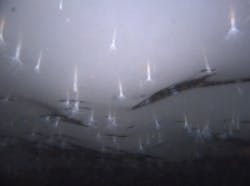Vision-guided underwater robot discovers new species of sea anemones living in ice
A camera-equipped underwater robot deployed by the Antarctic Geological Drilling (ANDRILL) program found a new species of small sea anemones living in the underside of the Ross Ice Shelf off Antarctica.
The 4.5-foot cylindrical subsea remotely operated vehicle (ROV) is comprised of a front-maneuvering thruster model, an electronics housing unit, a rear-maneuvering thruster module, a main thruster module and tether attachment point. The ROV, called the submersible capable of under-Ice navigation and imaging (SCINI), has a vision system consisting of a camera module with a tilting-forward camera and fish-eye lens, forward lights, a fixed-downward camera, downward lights, scaling lasers, and a projection cage.
SCINI’s two cameras were Elphel 353 network cameras, which are created using free software and open hardware. The downward-looking camera used was a 5 MPixel Elphel 353 camera with an internal FPGA that handles pipelined image processing and an embedded system running Linux that dealt with peripherals and communication. The camera features a 1/2.5” Bayer pattern Aptina CMOS image sensor, region of interest mode and on-chip binning capabilities. In addition, an Elphel 1.2 MPixel camera was used for the forward-looking camera. In order to study the underside of the ice, SCINI was operated inverted, so the larger format camera was primarily responsible for close up images, and the forward-looking camera provided a view of the anemones.
This particular project, called the ANDRILL Coulman High Project, saw ROVs deployed in a completely new method, according to Frank Rack, executive director of the ANDRILL Science Management Office at the University of Nebraska-Lincoln (UNL) and associate professor of Earth and atmospheric sciences at UNL.
"ANDRILL Coulman High Project site surveys were the first time that SCINI or any other ROV was deployed through an ice shelf," Rack told Vision Systems Design. "The ice shelf was 250-270m thick in the areas that the dives were performed. There were a total of 14 dives at two sites over several days, with the longest dive being slightly over 9 hours long."
Page 1 | Page 2
About the Author

James Carroll
Former VSD Editor James Carroll joined the team 2013. Carroll covered machine vision and imaging from numerous angles, including application stories, industry news, market updates, and new products. In addition to writing and editing articles, Carroll managed the Innovators Awards program and webcasts.

